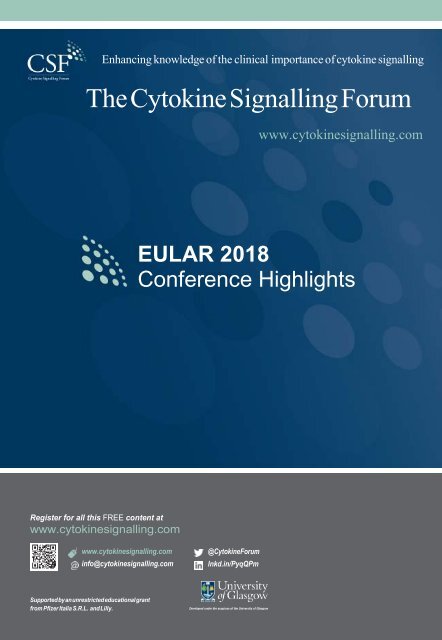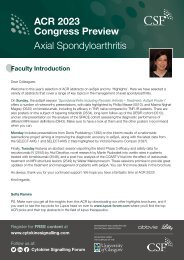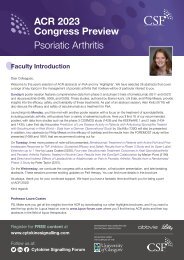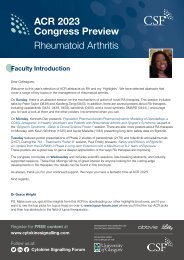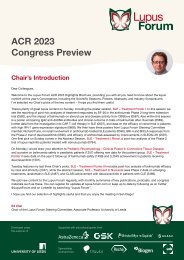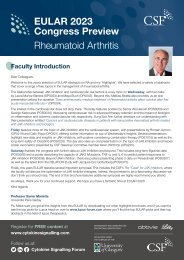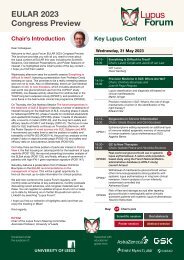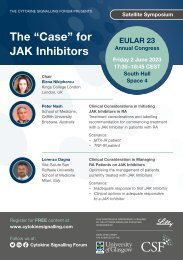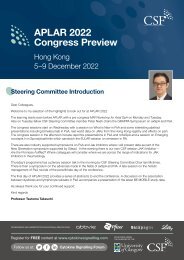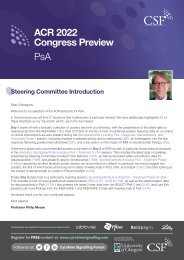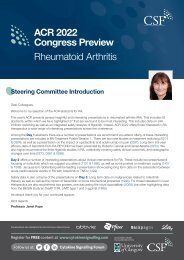EULAR 2018 Review
Create successful ePaper yourself
Turn your PDF publications into a flip-book with our unique Google optimized e-Paper software.
Enhancing knowledge of the clinical importance of cytokine signalling<br />
The Cytokine Signalling Forum<br />
www.cytokinesignalling.com<br />
<strong>EULAR</strong> <strong>2018</strong><br />
Conference Highlights
<strong>EULAR</strong> <strong>2018</strong><br />
Conference Highlights<br />
Chairman’s Welcome<br />
Dear CSF Member,<br />
It is my pleasure to bring to you our review of the <strong>EULAR</strong> <strong>2018</strong> highlights, including a review of my ‘Chairman’s picks’.<br />
This year, there continues to be considerable data published on JAK inhibition, with differences in the JAK-STAT<br />
signalling pathway in synovial fibroblasts analysed in different joints [#OP0165], and the results of a systematic review<br />
and meta-analysis of Phase 2 and 3 JAK inhibitor studies presented for the risk of patients developing malignancies or<br />
serious infections [#OP0032].<br />
It was exciting to see the Phase 3 data for upadacitinib: Burmester et al shared the results from patients with an<br />
inadequate response to csDMARDs [#OP0036]; Genovese et al, presented the safety and efficacy of upadacitinib in<br />
bDMARD inadequate responders [#SAT0219]; and Smolen et al evaluated updacitinib as monotherapy [#OP0035]. We<br />
also saw the results of a Phase 2b/3 study of upadactinib in Japanese patients [#SAT0257].<br />
Tofacitinib continues to be prominent this year: data from the ORAL Strategy trial were presented, including the impact of<br />
glucocorticoids on tofacitinib efficacy and safety [#SAT0247], and the effect of live zoster vaccination [#SAT0220]; while<br />
Kaine et al presented data on tofacitinib discontinuation and re-initiation in long-term extension studies [#OP0037].<br />
Specific considerations included a comparison of the effectiveness of tofacitinib and bDMARDs in clinical practice<br />
[#AB0485], improvements in left ventricular mass and cardiac output [#AB0489]; and identification of subgroups, which<br />
could be used to develop personalised treatment algorithms [SAT0217].<br />
Baricitinib showed interesting and varied data, with post hoc analyses from Phase 3 trials examining the impact of<br />
controlling disease activity on physical function, and pain [#AB0258]. The effects of dose reduction were investigated<br />
[#SAT0253] and hepatitis B reactivation was examined [#FRI0077]; efficacy and safety of baricitinib were reported from<br />
the Phase 3 study RA-BALANCE, which enrolled patients in China, Argentina and Brazil [#SAT0218].<br />
Beyond RA, there were data in psoriatic arthritis (PsA); the effects of tofacitinib on several composite endpoint measures<br />
were presented from OPAL Broaden and Beyond [#THU0323]; and efficacy analysed by background methotrexate dose<br />
[#AB0902], and by baseline demographics, disease activity and concomitant medications [#AB0921]. The efficacy and<br />
safety of tofacitinib in patients with or without metabolic syndrome were also compared [SAT0317]. The safety,<br />
tolerability and efficacy of tofacitinib over 36 months were presented from the ongoing OPAL Balance study [SAT0293].<br />
Also of interest was an evaluation of the effect of tofacitinib on the ability of monocytes to differentiate into dendritic cells,<br />
an important step in innate immunity [#AB0046].<br />
The following pages provide a review of the highlights from <strong>EULAR</strong> <strong>2018</strong>. Once again, thank you for your support, and<br />
we hope you enjoyed your time at <strong>EULAR</strong>.<br />
Yours,<br />
Prof. Iain McInnes
Highlights from <strong>EULAR</strong> <strong>2018</strong><br />
During the <strong>EULAR</strong> <strong>2018</strong> annual meeting, many presentations and posters reported on<br />
cytokine signalling and related drugs. This document reviews the highlights.<br />
Oral presentations<br />
Abstract Session: RA therapy - new molecules and new strategies<br />
Upadacitinib Phase 3 results<br />
Phase 3 results for upadacitinib in 661 patients with RA and inadequate response (IR) to<br />
csDMARDs were reported in an oral presentation by Burmester, et al. At Week 12,<br />
significantly more patients receiving upadacitinib 15 mg and 30 mg QD versus placebo<br />
achieved an ACR20 response (63.8% and 66.2% vs 35.7%, P
interruption visit, AEs, SAEs and discontinuations due to AEs occurred in 54.4%, 11.1%<br />
and 1.5% of patients, respectively. The authors concluded that there was no loss of<br />
efficacy after temporary withdrawal of tofacitinib, and that the safety profile was consistent<br />
with that observed in previous LTE studies over 9 years [#0037].<br />
Malignancy and serious infection rates in clinical trials of JAK inhibitors for RA<br />
Lopez-Olivio, et al. presented a systematic review and meta-analysis of malignancies and<br />
serious infections during randomised controlled trials of JAK inhibitors in patients with RA.<br />
Thirty-one trials including 13 945 patients were included. Reported rates of malignancies<br />
across studies ranged from 0% to 2.0%, and rates of serious infections ranged from 0.7%<br />
to 5.4%. The most commonly reported malignancies were lung cancer, melanoma,<br />
nonmelanoma skin cancer (NMSC), basal cell and squamous cell carcinoma. Patients<br />
receiving the combination of JAK inhibitor plus MTX or JAK inhibitor monotherapy had<br />
numerically higher rates of malignancies, compared with MTX between 12 and 24 weeks<br />
before the rescue treatment was implemented (odds ratio [OR] 2.48, 95% confidence<br />
intervals [CI] 0.76–8.11 and OR 1.39, 95% CI 0.21–9.11, respectively). JAK inhibitor<br />
groups had similar rates of serious infections to those observed in the control groups.<br />
However, higher rates of serious infections were observed in patients receiving higher<br />
doses of JAK inhibitors [#0032].<br />
Abstract Session: Fires and firefighters: switching the immune system on and off<br />
Joint-specific differences in activation of the JAK-STAT pathway in RA<br />
Masterson and colleagues presented findings on substantial quantitative and qualitative<br />
differences in the JAK-STAT signalling pathway in synovial fluid (SF) from different joints.<br />
Using synovial fluid isolated from knee, shoulder and hand joints from patients with RA and<br />
osteoarthritis who were undergoing joint replacement surgery, the authors showed that the<br />
JAK-STAT pathway was enriched in knee SF versus hand and shoulder SF. Knee SF<br />
exhibited increased expression of JAK and STAT genes and enhanced signalling upon<br />
stimulation with IL-6/sIL-6R. The authors suggest that RA in different joints might not be<br />
equally sensitive to JAK-kinase inhibitors or blockade of IL-6, which has important<br />
implications for clinical practice and drug discovery in this therapy area [#0165].
Poster Sessions<br />
Poster Tour: Novel insights on non-biologics in RA<br />
Efficacy and safety of baricitinib at 52 weeks in the Phase 3 RA-BALANCE trial<br />
Li and colleagues presented 52-week efficacy and safety results from the Phase 3 RA-<br />
BALANCE trial. The study enrolled patients from China, Argentina and Brazil with<br />
moderately to severely active RA despite a stable background of MTX; patients received<br />
baricitinib 4 mg QD or PBO for 24 weeks, when patients receiving placebo were switched<br />
to receive baricitinib 4 mg QD until end of study. The primary endpoint, ACR20 at Week<br />
12, was significantly greater with baricitinib compared with placebo (58.6% versus 28.3%,<br />
P≤0.001). The ACR20 response observed at 12 weeks was maintained through 52 weeks<br />
in patients receiving baricitinib (Week 24: 64.1%; Week 52, 62.8%). Significant<br />
improvements in HAQ-DI physical function (PF), duration and severity of morning joint<br />
stiffness, and worst tiredness were observed at Week 12 with baricitinib versus placebo.<br />
Treatment-emergent adverse events (TEAEs) and serious infections during Weeks 0–24<br />
were reported in 74.5% and 42.1% of baricitinib patients (respectively) compared with<br />
62.1% and 28.3% of patients receiving placebo. No major adverse cardiovascular events<br />
(MACE), deaths, TB, venous thromboembolisms or malignancies were reported through<br />
Week 52 with baricitinib, and no unexpected safety signals were observed [#0218].<br />
Upadacitinib Phase 3 study results<br />
A poster by Genovese, et al. presented the results of a Phase 3, randomised, placebocontrolled<br />
trial of upadacitinib in patients with active RA and an inadequate response or<br />
intolerance to bDMARDs. In this study, patients received upadacitinib 15 mg or 30 mg QD,<br />
or placebo, followed by upadacitinib 15 mg or 30 mg QD starting at Week 12. Compared<br />
with placebo, more patients receiving upadacitinib achieved the primary endpoints of<br />
ACR20 and proportion achieving DAS28CRP≤3.2 (both at Week 12). Among patients with<br />
an inadequate response to multiple bDMARDs/MOAs, and those with lack of efficacy for<br />
alpha-IL-6, the proportions achieving ACR20 on upadacitinib versus placebo were<br />
comparable to the overall treated population. Overall rates of AEs were slightly higher for<br />
upadacitinib 30 mg QD versus upadacitinib 15 mg QD, and there were more serious<br />
infections and HZ cases in patients receiving upadacitinib 30 mg. PE was reported in two<br />
patients through Week 12, and four more patients through Week 24; all had risk factors for<br />
DVT/PE. One death in each upadacitinib dose group was reported. The overall safety<br />
profile was considered consistent with Phase 2 and other Phase 3 studies of upadacitinib<br />
[#0219].<br />
Tofacitinib and the effect of live zoster vaccine on herpes zoster events in RA<br />
Calabrese, et al. presented an evaluation of LZV in a subset of 1146 patients with RA<br />
treated with tofacitinib with or without MTX, and adalimumab plus MTX in ORAL Strategy.<br />
A total of 216 patients received vaccination with LZV. No patients had zoster-like lesions<br />
within 42 days of vaccination; one had vaccination-site erythema. In the overall study<br />
population, the incidence rate of HZ was similar between tofacitinib monotherapy and<br />
adalimumab plus MTX, and numerically higher with tofacitinib plus MTX. Overall, 18<br />
patients had HZ; only three vaccinated patients had HZ. No events were serious, and only
1 case was multidermatomal. Among the patients who were not vaccinated, 15 had HZ,<br />
there were 2 serious HZ events, 2 multidermatomal events and 1 disseminated event<br />
[#0220].<br />
Identification of heterogeneous phenotypic subgroups of patients with RA<br />
Bykerk and colleagues reported that it is possible to identify heterogeneous phenotypic<br />
subgroups with distinct disease activity in patients with RA who are csDMARD-IR and<br />
treated with tofacitinib. Models were based on pooled data from Phase 3 studies of<br />
tofacitinib 5 mg BID. The groups were characterised by differences in disease activity and<br />
patient-relevant outcomes, including baseline pain and physical function. The authors<br />
proposed that the identification of distinct disease trajectories could be used to develop<br />
personalised treatment algorithms incorporating clinical and molecular phenotypes<br />
[#0217].<br />
Poster Tour: Breakout news on non-TNF biologics in RA<br />
Real world evidence: bDMARD treatment persistence and reasons for discontinuation<br />
A poster on reasons for bDMARD cessation and subsequent persistence of second-line<br />
treatment in a large real world rheumatoid arthritis registry was presented by Youssef, et<br />
al. The analysis included patients aged ≥18 years with confirmed RA who were treated<br />
with first line b/tsDMARDs (1 st August 2010 to 30 th June 2017) by physicians participating<br />
in the OPAL-QUMI database. A total of 6914 patients received first line b/tsDMARDs.<br />
Treatment was stopped in 38% of patients; 34% stopped within 6 months of initiation, with<br />
the highest and lowest percentage observed in patients receiving tofacitinib (54%) and<br />
tocilizumab (17%), respectively. The most common reasons for stopping therapy within 6<br />
months were lack of efficacy (45%>abatacept, 44%>TNFis, 33%>tofacitinib and<br />
27%>tocilizumab) and adverse reactions (21%> tofacitinib, 20%> tocilizumab,<br />
15%>TNFis, 13%>abatacept). The percentage of patients remaining on 2nd line<br />
b/tsDMARD treatment after stopping first line TNFis due to lack of efficacy was the highest<br />
at 6 months with tocilizumab (78%) and at 12 months with rituximab (75%) [#0165].<br />
Poster Tour: The hydra beast in RA: a multifaceted disease<br />
Tofacitinib development programme: liver enzyme abnormalities<br />
Soriano, et al. reported a prevalence of hepatic steatosis of 1.6% in 10,212 patients across<br />
the tofacitinib RA, PsA and PsO programmes (1.3% in RA, 3.8% in PsA and 1.6% in PsO).<br />
In both tofacitinib- and placebo-treated patients, the incidence of elevated total bilirubin,<br />
aspartate aminotransferase (AST) and alanine aminotransferase (ALT) >1x ULN up to<br />
Month 3 was higher in patients with hepatic steatosis than in those without, across<br />
indications. The incidence of elevated total bilirubin, AST and ALT >3x ULN up to Month 3<br />
was low across indications, irrespective of hepatic steatosis [#0099].
Poster sessions I, II and III<br />
Upadacitinib efficacy and safety in RA<br />
FitzGerald, et al presented findings from the Phase 3 SELECT-NEXT (n=661) and<br />
SELECT-BEYOND (n=498) trials on the speed of response to upadacitinib across disease<br />
measures. In these cohorts of patients with RA and an inadequate response to csDMARDs<br />
or bDMARDs, those receiving upadacitinib at either 15 mg or 30 mg QD were more likely<br />
to achieve clinical responses at significantly earlier timepoints compared with patients<br />
receiving placebo. The median times to achieve ACR20 were 4 weeks with upadacitinib 15<br />
mg QD, 2–3 weeks with upadacitinib 30 mg QD, and 12 weeks with placebo. The median<br />
time to low disease activity (LDA) by CDAI and SDAI was approximately 12 weeks across<br />
upadacitinib doses and populations; patients receiving placebo did not achieve this<br />
measure within that time. The time taken to achieve various clinical responses was<br />
consistent irrespective of having an inadequate response to csDMARD or bDMARD<br />
[#0239].<br />
Vollenhoven, et al. examined upadacitinib efficacy at 12 weeks of treatment (as per T2T<br />
recommendations) in the SELECT-NEXT and SELECT-BEYOND trials. In both<br />
populations of patients with RA, significantly more patients on upadacitinib versus placebo<br />
achieved an ACR50 response. Among ACR50 responders at 12 weeks, approximately<br />
one-half of csDMARD-IR patients and one-third of the bDMARD-IR patients achieved an<br />
improvement in all 7 ACR components [#0244].<br />
Genovese, et al. presented the long-term safety and efficacy profile for upadacitinib from<br />
an ongoing open-label, long-term extension (OLE) of two Phase 2 studies (BALANCE-<br />
EXTEND). This included 493 patients with RA, with a total of 725 patient-years of<br />
cumulative exposure. The event rate per 100 patient years (E/100PY) was 170.5 for any<br />
AE in the OLE, 9.4 for SAEs, 2.3 for serious infection, 3.7 for HZ, 0.8 for malignancies<br />
excluding NMSC, and 0.7 for adjudicated cardiovascular events. There were 2 deaths (1<br />
sudden death adjudicated as unknown cause, and 1 due to Hodgkin’s lymphoma). Efficacy<br />
was maintained in patients receiving 6 mg upadacitinib BID from Day 1 of the OLE who<br />
completed Week 72 (55% of patients met ACR70, and 80% were in LDA by DAS28-CRP<br />
and CDAI) [#0236].<br />
The results of a Phase 3/4, randomised, placebo-controlled, double-blind study of<br />
upadacitinib in Japanese patients with active RA and an inadequate response to<br />
csDMARDs were presented in a poster by Tanaka, et al. A total of 197 patients received<br />
treatment and 187 completed the double-blind period. ACR20 rates at 12 weeks in patients<br />
receiving upadacitinib 7.5, 15, and 30 mg or placebo were 75.5%, 83.7%, 80% and 42.9%,<br />
respectively. ACR50 and ACR70 responses were achieved by significantly higher<br />
proportions of patients receiving upadacitinib versus placebo; more patients receiving<br />
upadacitinib 15 mg and 30 mg achieved these responses compared with those receiving<br />
upadacitinib 7.5 mg. The overall safety and tolerability profile was consistent with that<br />
observed in Phase 2 and 3 studies to date. Rates of any AEs, SAEs and infections were<br />
numerically higher in patients receiving upadacitinib 30 mg compared with the lower<br />
upadacitinib doses and placebo groups; CPK elevations and lymphopenia occurred more<br />
frequently with upadacitinib 30 mg [#0257].
Effect of upadacitinib on patient-reported outcomes in RA<br />
Strand, et al. presented two posters on patient-reported outcomes (PROs) with<br />
upadacitinib in the SELECT-NEXT and SELECT BEYOND studies. A total of 661 patients<br />
with active RA and an inadequate response to csDMARD were included in the analysis of<br />
PROs in SELECT-NEXT. Treatment with upadacitinib 15 mg or 30 mg daily for 12 weeks<br />
resulted in significant and clinically meaningful improvements in physical function, pain,<br />
fatigue, morning stiffness, QoL and work instability. Numbers Needed to Treat (NNT) with<br />
upadacitinib ranged from 4 to 8 patients [#0254]. A total of 498 patients with active RA and<br />
an inadequate response to bDMARDs were included in the analysis of SELECT-BEYOND.<br />
Compared with placebo at Week 12, upadacitinib-treated patients reported higher<br />
responses that were statistically significant and clinically meaningful for HAQ-DI, PtGA<br />
pain, pain, duration and severity of morning stiffness and SF-36 Physical Component<br />
Summary (PCS). NNT with upadacitinib ranged from four to eight patients in this difficultto-treat<br />
cohort [#0255].<br />
Tofacitinib efficacy and safety in RA<br />
Fleischmann and colleagues presented a post hoc analysis of the ORAL Strategy study<br />
describing the impact of background glucocorticoids on the safety and efficacy of tofacitinib<br />
(with and without MTX) and adalimumab with MTX. Patients with RA were randomised<br />
1:1:1 to receive tofacitinib 5 mg BID, tofacitinib 5 mg BID plus MTX, or SC adalimumab 40<br />
mg (every other week) plus MTX. In the cohort of 1146 patients who were randomised and<br />
treated, efficacy endpoints (ACR50 response rate, LDA, remission rates, change in HAQ-<br />
DI score) were generally similar for each treatment group when stratified by glucocorticoid<br />
use. Unexpectedly, glucocorticoid use did not appear to be associated with higher rates of<br />
AEs, discontinuations due to AEs, serious infection events, and SAEs [#0247].<br />
Cumulative probability plots showing clinical and functional efficacy across treatments for<br />
patients with RA in the ORAL Strategy study were presented by Takeuchi, et al. The<br />
proportion of patients who achieved responses of ACR20, ACR50 and ACR70 was similar<br />
for tofacitinib 5 mg BID plus MTX, and adalimumab SC 40 mg (every other week) plus<br />
MTX every other week but was numerically smaller for tofacitinib 5 mg BID monotherapy.<br />
Reductions from baseline in HAQ-DI were similar across treatment groups, although a<br />
slightly higher proportion of patients who received tofacitinib monotherapy reported an<br />
increase in HAQ-DI compared with other treatments. These data are consistent with the<br />
primary ORAL Strategy findings [#0252].<br />
Wiesenhutter examined the utility of various disease activity measures (DAMs) for clinical<br />
decision making during implementation of a treat-to-target (T2T) strategy, following the<br />
initiation of tofacitinib (n=39) and TNFis (n=40). Patients at a rheumatology clinic<br />
underwent disease activity measure (DAM) assessments, which included conventional<br />
clinical assessments, DAS28CRP, and the CDAI, as well as the ultrasound power Doppler<br />
joint count (UPDJC) and multi-biomarker disease activity score (MBDA). Patients<br />
underwent regular assessments, and if found to have inadequate control, changes were<br />
made in their clinical regimen and reassessment was performed 3 to 6 months later. All of<br />
the DAMs resulted in significant clinical responses with the exception that following the<br />
initiation of tofacitinib, the MBDA did not result in clinically significant improvement. When<br />
individual biomarkers from the MBDA were analysed, TNFi therapy led to significant<br />
reduction in 6 of 12 biomarkers (IL-6, TNF-R1, TNF-R2, MMP-2, SSA and CRP), whereas
treatment with tofacitinib lead to significant reduction of 2 (VCAM and resisten) and<br />
borderline reduction in 2 (IL-6 and TNF-R1), and a significant increase in one (leptin).<br />
[#0089].<br />
Effect of tofacitinib on patient-reported outcomes in RA<br />
Patient-reported outcomes (PROs) in the ORAL Strategy study were reported by Strand<br />
and colleagues. Patients with RA and an inadequate response to MTX were randomised<br />
1:1:1 to receive tofacitinib 5 mg BID, tofacitinib 5 mg BID plus MTX, or adalimumab 40 mg<br />
(SC, Q2W) plus MTX; PROs were assessed at 6 and 12 months, and included HAQ-DI,<br />
patient global assessment (PtGA) visual analog scale) VAS, pain VAS, SF-36 Health<br />
Survey, EuroQol (EQ)-5D VAS, Work Productivity and Activity Impairment (WPAI) and<br />
Functional Assessment of Chronic Illness Therapy-Fatigue (FACIT-F). Baseline and<br />
disease characteristics were similar among the 1146 treated patients. At 6 and 12 months,<br />
improvements in PROs were similar with tofacitinib plus MTX and adalimumab plus MTX,<br />
and were numerically greater than with tofacitinib monotherapy [#0256].<br />
Tofacitinib efficacy and safety in PsA<br />
Helliwell, et al. showed that tofacitinib improved composite measures of disease in 2<br />
Phase 3 studies of patients with PsA. Patients with active PsA and either an inadequate<br />
response to ≥1 csDMARD and who were TNFi-naïve (OPAL Broaden; N=422) or with an<br />
inadequate response to ≥1 TNFi (OPAL Beyond; N=394) were assessed for Psoriatic<br />
Arthritis Disease Activity Score (PASDAS), DAS28-3(CRP), disease activity score for<br />
reactive arthritis (DAREA)/ Disease Activity index for Psoriatic Arthritis (DAPSA) and<br />
CPDAI. In each study, both 5 mg BID and 10 mg BID doses of tofacitinib showed<br />
improvements in composite endpoints versus placebo at 3 months; the largest effect size<br />
and standardised response means were observed for PASDAS [#0323].<br />
A post hoc analysis of the OPAL Broaden and OPAL Beyond studies was presented by<br />
Ritchlin and colleagues; this analysis examined tofacitinib efficacy and safety in patients<br />
with PsA and comorbid metabolic syndrome (MetS) and included 294 patients with active<br />
PsA plus MetS, and 416 patients with active PsA and without MetS. Tofacitinib efficacy<br />
was generally similar in patients with and without MetS, as determined by ACR20<br />
response rate, change in HAQ-DI, Psoriasis Area and Severity Index (PASI)75 response<br />
rate, change in and PtGA VAS. In patients with MetS, AEs and SAEs occurred in 55.6%<br />
and 2.0% (respectively) of patients receiving tofacitinib 5 mg, and in 42.6% and 2.0% of<br />
those receiving tofacitinib 10 mg; corresponding rates in patients without MetS were 42.4%<br />
and 1.4% (5 mg) and 54.8% and 1.5% (10 mg). The authors concluded that tofacitinib<br />
showed a generally similar efficacy and safety profile in patients with PsA with or without<br />
MetS [#0317].<br />
Burmester, et al. reported minimal changes in absolute lymphocyte counts and lymphocyte<br />
subset counts in tofacitinib-treated patients with PsA, up to 6 months. An analysis of<br />
pooled data the Phase 3 OPAL Broaden and OPAL Beyond studies of tofacitinib in 816<br />
patients with PsA who had an inadequate response to ≥1 csDMARD or ≥1 TNFi found<br />
minimal decreases in total T cells (CD3+), cytotoxic T cells (CD8+) NK cells (CD16+56+)<br />
and a numerical increase in B cells (CD19+). Up to Month 12, serious infections were<br />
reported in seven tofacitinib-treated patients and one adalimumab-treated patient. There
was no suggestion of an increased risk of serious infection in any absolute lymphocyte<br />
count category [#0330].<br />
The third interim analysis of OPAL Balance, an open-label LTE study of tofacitinib in<br />
patients with PsA, was reported by Nash, et al. Of the 686 patients treated in the study,<br />
468 remained in the study at data cut-off. To 36 months, 2186 AEs were reported in 79.6%<br />
of patients. SAEs, discontinuations due to AEs and serious infections were reported in<br />
13.8%, 8.6% and 1.7% of patients, respectively.<br />
HZ was reported in 2.9% of patients, MACE in 0.7%, malignancies in 3.5% (including 12<br />
pts with NMSC) and uveitis in 0.3%. No AEs of GI perforation or inflammatory bowel<br />
disease were reported. There were 5 deaths, none of which were attributed to treatment as<br />
assessed by the investigator. The authors concluded that over 36 months in the LTE, the<br />
safety profile of tofacitinib in patients with active PsA was generally similar to that of the<br />
Phase 3 studies. Efficacy was maintained across multiple disease domains to Month 30<br />
[#0293].<br />
Effect of tofacitinib on patient-reported outcomes in RA, PsA and AS<br />
Ogdie, et al. showed that tofacitinib treatment (5 mg BID or 10 mg BID) was associated<br />
with a rapid and sustained reduction of pain in patients with RA, PsA and AS. In patients<br />
with RA or PsA who were csDMARD-IR or TNFi-IR, mean Patient's Assessment of Arthritis<br />
Pain (PAAP)-VAS at baseline (5 mg BID, range 55.7–65.7 mm; 10 mg BID, 54.4–60.1 mm)<br />
decreased as early as Week 2 and continued to decrease through Month 6 (30.9–34.4<br />
mm; 28.2–36.7 mm); decreases were numerically greater versus placebo and the<br />
magnitude of change was similar in RA and PsA populations. Improvements in SF-36v2<br />
and EQ-5D were observed in all four RA and PsA csDMARD-IR and TNFi-IR populations;<br />
there were improvements in Bath Ankylosing Spondylitis Disease Activity Index (BASDAI)<br />
in the csDMARD-IR PsA and TNFi-IR PsA populations. In the AS population,<br />
improvements from baseline in SF-36v2 Q7, SF-36v2 bodily pain (BP) domain, EQ-5D<br />
Pain/Discomfort (PD) domain and BASDAI Q2, were observed at Week 12 and were<br />
numerically greater than with placebo [#0221].<br />
No evidence for increased risk of DVT or PE with tofacitinib across disease states<br />
Mease and colleagues reported an analysis of DVT and PE across randomised clinical<br />
studies of tofacitinib in patients with RA, PsO, PsA and ulcerative colitis (UC). Up to Month<br />
3 in the placebo-controlled cohort, DVT and PE occurred in two patients receiving placebo<br />
(n=1 RA, n=1 UC); no tofacitinib-treated patients had DVT or PE events. In the dose<br />
comparison cohort, 2 DVT events occurred in tofacitinib-treated patients with RA (5 mg<br />
BID, n=1; 10 mg BID, n=1) and 1 DVT event in a patient with PsA (10 mg BID, n=1); 2<br />
DVT events occurred with MTX and none with adalimumab. With tofacitinib, 5 PE events<br />
occurred in the dose comparison cohort, all in patients with RA (5 mg BID, n=2; 10 mg<br />
BID, n=3). The authors concluded that there is no evidence for an increased risk of these<br />
events with tofacitinib versus other therapies [#0243].
Baricitinib dose step-down following sustained disease control<br />
The effects of baricitinib dose step-down in patients with RA who achieved sustained<br />
disease control with baricitinib 4 mg were presented by Takeuchi, et al. Patients who<br />
participated in the baricitinib Phase 3 LTE study and received baricitinib 4 mg for ≥15<br />
months, and achieved LDA or remission, were re-randomised to continue baricitinib 4 mg<br />
(n=374) or step-down to baricitinib 2 mg (n=376); patients could rescue to 4 mg. Most<br />
patients in both groups maintained LDA or remission over the 48 weeks; however, dose<br />
reduction to 2 mg resulted in significant increases in disease activity at 12, 24 and 48<br />
weeks, and a shorter time to relapse compared with the 4-mg group. Rates of SAEs and<br />
AEs leading to discontinuation were similar between groups; however, dose reduction was<br />
associated with a lower rate of serious infections. Most rescued patients were able to<br />
regain LDA or remission [#0253].<br />
Baricitinib: HBV reactivation and autoantibody profiling<br />
Harigai and colleagues presented the findings of a post hoc analysis examining hepatitis B<br />
virus (HBV) reactivation in patients with RA who participated in 4 Phase 3 trials of<br />
baricitinib. In a total of 2890 patients who received 1 or more dose of baricitinib (6993<br />
patient-years exposure), 269 patients had baseline serology suggestive of prior infection<br />
and post-baseline HBV DNA tests were performed in 290 patients. Approximately 12% of<br />
baricitinib-treated patients with prior HBV infection later tested positive for HBV DNA (3%<br />
were above the lower limit of detection); no patients developed clinical evidence of<br />
hepatitis, and antiviral therapy was not commonly required [#0077].<br />
An exploratory analysis of autoantibody profiles for response to baricitinib in patients with<br />
RA and no or limited exposure to MTX was presented by Martinez-Gamboa, et al. Baseline<br />
sera samples from patients participating in the Phase 3 trial RA-BEGIN were investigated<br />
for auto-antibody class reactivity towards vimentin (V), modified by citrullation (MCV),<br />
carbamylation (Carb) or acetylation. Seropositive patients with high titres of anti-MCV and<br />
anti-CarbV at baseline showed better responses to baricitinib monotherapy or baricitinib<br />
plus MTX for composite scores, and better response to baricitinib monotherapy in<br />
structural progression outcomes [#0109]<br />
Patient-reported outcomes with baricitinib<br />
Bingham and colleagues reported an analysis of PROs from the Phase 3 RA-BEAM and<br />
RA-BEACON trials of baricitinib in patients with RA with an inadequate response to MTX.<br />
FACIT-F and SF-36 BP scores were converted to Patient-Reported Outcomes<br />
Measurement Information System (PROMIS) Fatigue and Pain Interference (PI) scores, to<br />
permit comparisons with the general population. In both studies, baricitinib was associated<br />
with clinically relevant improvements through 24 weeks versus placebo for PROMIS<br />
fatigue and PI scores [#0106]. In a separate analysis, the authors converted HAQ-DI<br />
scores to PROMIS Physical Function (PF) scores. Treatment with baricitinib was<br />
associated with clinically relevant improvements in PROMIS PF versus placebo through 24<br />
weeks in both studies, and versus adalimumab through 52 weeks in RA-BEAM [#0013].
Real-world evidence: patterns of use with JAK inhibitors<br />
Chastek, et al. reported real-world patterns of use in biologic-naïve and biologicexperienced<br />
patients with RA who were newly prescribed a JAKi. In this retrospective<br />
analysis of 1059 patients (80.2% biologic-experienced), 72.4% of patients were not<br />
persistent for the 1-year following initiation of a JAKi, and 39.1% were not persistent<br />
beyond 90 days. For non-persistent patients, 42% interrupted JAKi treatment and<br />
restarted, 30% switched to a bDMARD and 28% discontinued. More biologic-naïve than<br />
biologic-experienced patients neither initiated a bDMARD nor restarted a JAKi after<br />
interruption (44.2% versus 23.3%, respectively; P
Publication only<br />
Efficacy and safety of tofacitinib for RA in clinical practice<br />
Aramaki, et al reported 52-week efficacy and safety with tofacitinib in patients with RA<br />
treated in routine clinical practice in Japan. In this cohort of 77 patients (n=23 biologicalnaïve)<br />
who all received tofacitinib 5 mg BID, the drug survival rate was 73.8% at 52 weeks;<br />
n=27 patients were treated for 104 weeks. Mean ESR-DAS decreased from 5.15 at<br />
baseline to 3.52 at 24 weeks, and 3.59 at 52 weeks. Mean CDAI decreased from 21.5 at<br />
baseline to 7.94 at 24 weeks, and 7.93 at 52 weeks. At 52 weeks, 16 patients (20.8%)<br />
achieved remission (DAS-ESR
for discontinuing tofacitinib were insufficient response (n=23), GI symptoms (n=18),<br />
infection (n=5), myalgia (n=2), remission (n=2), headache (2), cough, blue toe syndrome,<br />
intolerance, heart burn, psoriasis, and increased liver enzymes (all n=1). The authors<br />
concluded that tofacitinib is a safe and effective treatment option for patients with RA<br />
[#0497].<br />
Zengin and colleagues reported data from the Turkish TURKBIO registry on tofacitinib<br />
efficacy and safety in 180 patients with RA. Median duration of disease activity was 14<br />
years, and 75 patients had previously used ≥1 biologic agent. All disease activity<br />
parameters were significantly reduced versus baseline after 12 weeks of treatment, with<br />
6%, 59% and 27% of patients achieving remission, or with a moderate or high activity<br />
level, respectively. Most disease activity parameters were maintained until Week 60, the<br />
last examined time point. During the follow-up period, 9 AEs were observed [#0482].<br />
Drug survival rates with tofacitinib in RA: a single-centre cohort study<br />
Drug survival rates of tofacitinib in a single-centre cohort of 192 patients with RA with a<br />
median disease duration of 10 years were reported by Karakoc, et al. Approximately half of<br />
the cohort (48%) were biologic-naïve; tofacitinib was prescribed as monotherapy in 58% of<br />
patients and in combination with csDMARDs in 42% of patients. Drug survival rates were<br />
77% at 3 months, 69% at 6 months, 62% at 12 months, 54% at 18 months, 49% at 24<br />
months and 49% at 30 months. Discontinuation of tofacitinib treatment occurred in 27% of<br />
patients due to lack of response, and in 11% of patients due to side effects [#0502].<br />
Tofacitinib dose escalation and subsequent reduction in patients with RA<br />
Gaylis and colleagues reported data from a study of nine patients who were initially<br />
unresponsive to treatment with tofacitinib 5 mg BID and who were subsequently dose<br />
escalated to 10 mg BID to achieve LDA or remission. After 6 months of treatment with 10<br />
mg BID and a sustained LDA or remission, the patients were reduced back to 5 mg BID;<br />
six of nine patients were able to maintain LDA or remission over the following 6 months,<br />
and three patients were dose escalated back to 10 mg BID and achieved treatment target.<br />
These findings confirm that 10 mg BID of tofacitinib may be the effective dose required to<br />
reach treatment target for some patients with active RA and suggest that there is<br />
opportunity to reduce the escalated dose back down to the standard dose following<br />
achievement of a target response [#0282].<br />
Improvement of left ventricular mass and cardiac output with tofacitinib<br />
In a cohort study, Kume, et al. showed that tofacitinib monotherapy improved left<br />
ventricular mass and cardiac output in 24 patients with active RA (despite treatment with<br />
csDMARDs) and chronic heart failure. Tofacitinib significantly attenuated left ventricular<br />
mass as measured with cardio-MRI at baseline and 24 weeks; these effects were<br />
independent of tofacitinib’s effects on disease activity. The authors propose that the JAK-<br />
STAT pathway may be important for left ventricular hypertrophy, and that blockade of this<br />
pathway by tofacitinib may prevent cardiovascular morbidity and mortality in patients with<br />
RA and chronic heart failure [#0489].
A case study of vasculitis in a patient with RA treated with tofacitinib<br />
Muraviev, et al. presented a case of polyarteritis nodosa (vasculitis) in a female patient<br />
with RA. The patient was hospitalised in December 2016 due to painful eruption of<br />
indurated nodules on her legs, ulceration of nodules on her legs, painful hip and ankle<br />
joints and morning stiffness; the patient had been receiving tofacitinib 10 mg/day since<br />
November 2015, with rapid achievement of minimum RA activity. Tofacitinib was<br />
discontinued in June 2016 due to increasing lab activity of vasculitis. Histopathology<br />
showed the presence of cutaneous and subcutaneous fat and destructive vasculitis, and<br />
acute, predominantly lobular panniculitis, suggestive of polyarteritis nodosa and other<br />
systemic vasculitis. A causal relationship between this adverse drug reaction and<br />
tofacitinib therapy was assessed as probable (Naranjo scale) [#0413].<br />
Musculoskeletal ultrasound for monitoring the effects of biologic therapy in RA<br />
Yu and colleagues reported that musculoskeletal ultrasound (MSUS) was a useful tool for<br />
monitoring and following-up the effects of biologic therapy in patients with RA, for the<br />
assessment of inflammatory and destructive changes. In a real-world study of 18 patients<br />
with RA who were treated with tofacitinib 5 mg BID for 12 weeks, there was a significant<br />
correlation between MSUS scores and conventional (clinical and laboratory) measures of<br />
disease activity [#0210].<br />
Tofacitinib in patients with PsA: pooled sub-analyses of OPAL Broaden and OPAL Beyond<br />
Kivitz, et al. investigated pooled data from OPAL Broaden and OPAL Beyond, looking at<br />
the efficacy of tofacitinib by background MTX dose in patients with PsA. In total, data from<br />
556 patients who received tofacitinib plus MTX or placebo plus MTX were included in this<br />
analysis. Most patients were treated with background MTX at doses ≤15 mg/week (66.7%;<br />
mean dose 12.6 mg/week) compared with >15 mg/week (33.3%; mean dose 19.8<br />
mg/week). At Month 3, tofacitinib 5 and 10 mg BID were generally associated with<br />
numerically greater ACR and HAQ-DI response rates and greater changes from baseline<br />
in HAQ-DI score compared with placebo. The magnitude of tofacitinib effects on efficacy<br />
outcomes appeared broadly similar between background MTX dose groups [#0902].<br />
In a second pooled sub-analysis of the OPAL Broaden and OPAL Beyond studies,<br />
Behrens and colleagues examined the impact of baseline demographics, disease activity<br />
and concomitant medication on ACR20 response rate and HAQ-DI. Compared with<br />
placebo, tofacitinib 5 and 10 mg BID consistently improved efficacy at Month 3 across all<br />
predefined subgroups evaluated (race, ethnicity, gender, geographic region, PsA duration,<br />
age, BMI, PsA subtype, distal inter-phalangeal joint involvement, arthritis mutilans status,<br />
spondylitis status, baseline CRP, PASDAS, PASI score, DSS=0, concomitant csDMARD,<br />
corticosteroid use), with the exception of current smoking status [#0921].<br />
A novel mechanism of action for tofacitinib<br />
Marzaioli, et al. reported preclinical results suggesting a novel mechanism of action for<br />
tofacitinib. Pre-treatment of monocyte-derived dendritic cells (Mo-DC) from patients with<br />
RA and PsA inhibited Mo-DC differentiation. Furthermore, the decreased ability of
monocytes to differentiate into dendritic cells translated into a functional impairment of<br />
phagocytic ability. NOX5 protein expression was significantly decreased in pre-treated Mo-<br />
DC from PsA patients, and to a lesser extent in cells from RA patients. The authors<br />
proposed that inhibition of Mo-DC development by tofacitinib may alter migration of DC to<br />
the joint and subsequent activation of the immune response [#0046].<br />
Post hoc analyses of baricitinib Phase 3 studies<br />
Hepatic safety in patients with RA who received isoniazid (INH) for latent TB (LTBI) was<br />
reported by Hsieh et al. In this post hoc analysis of data from 3 Phase 3 baricitinib studies<br />
(n=2516 patients; RA-BEAM, RA BUILD, RA BEACON), 246 patients reported LTBI and<br />
169 had confirmed laboratory data and received INH as LTBI treatment. The percentage of<br />
patients with greater than one times the ULN levels of ALT was numerically higher in<br />
patients in the INH group versus no INH, and was consistent across placebo, baricitinib<br />
and adalimumab treatment groups. No treatment interruptions or discontinuations were<br />
reported in INH users in the baricitinib or adalimumab groups. The authors concluded that<br />
the data do not suggest an increased hepatic safety risk in patients receiving baricitinib<br />
and INH concomitantly [#0098].<br />
A post hoc analysis of the RA-BEAM and RA-BEGIN studies in patients with RA was<br />
reported by de Vlam, et al. The analysis showed that controlling disease activity by<br />
achieving LDA or remission increases the chance to regain normal physical function and<br />
relieve pain, independent of treatment (baricitinib monotherapy, baricitinib plus MTX or<br />
adalimumab). The data from RA-BEAM may indicate that achieving no/limited pain at<br />
Week 12 may be more likely with baricitinib compared with adalimumab, when achieving<br />
remission (83% versus 73%) [#0258].<br />
Pope and colleagues reported a post hoc analysis of RA-BEAM. The authors showed that<br />
reductions in pain and fatigue were associated with improvements in regular daily<br />
activities, presenteeism and work productivity, with patients who reported lower levels of<br />
fatigue and pain tending to experience greater improvements compared with patients with<br />
higher levels of pain and fatigue. When patients achieved a minimal level of pain (pain<br />
VAS ≤10 mm), similar improvements in presenteeism and work productivity were observed<br />
regardless of fatigue level. Similar results were observed between treatment groups<br />
[#0240].<br />
Phase 1 pharmacokinetic studies with upadacitinib in volunteers with renal impairment<br />
Mohamed, et al. reported results from a Phase 1 study that examined the<br />
pharmacokinetics of upadacitinib in 24 volunteers with either normal renal function or mild,<br />
moderate or severe renal impairment. In participants with mild, moderate and severe<br />
hepatic impairment, point estimates for plasma exposure ratios following a single 15 mg<br />
dose were 1.18, 1.33 and 1.44 for AUC and 1.06, 1.11 and 1.14 for maximum plasma<br />
concentration, relative to participants with normal renal function. The authors concluded<br />
that renal impairment has only limited effect upon upadacitinib pharmacokinetics, with<br />
mean plasma exposure in participants with severe renal impairment within 44% of that<br />
observed in patients with normal renal impairment [#0479].
In a separate dedicated Phase 1 study, Mohamed and colleagues examined the<br />
pharmacokinetics of upadacitinib in 18 volunteers with either normal renal function, or mild<br />
or moderate renal impairment. In participants with mild and moderate hepatic impairment,<br />
upadacitinib exposure ratio central values following a single 15 mg dose were 1.28, 1.24<br />
for AUC and 1.04, and 1.43 for maximum plasma concentration, relative to participants<br />
with normal renal function. The authors concluded that renal impairment has very limited<br />
effect upon upadacitinib pharmacokinetics (
References<br />
• Aramaki T, Kojima K, Kurushima S, Tsuji Y, Kawachi N, Iwamoto N, Ichinose K, Terada K, Eguchi K, Ueki Y,<br />
Kawakami A. Efficacy and safety of tofacitinib (TOF) in patients with rheumatoid arthritis at 52 weeks in clinical<br />
practice. Abstract 0500.<br />
• Behrens F, Gomez-Reino J, Nash P, Gladman DD, FitzGerald O, Ritchlin C, Kudlacz E, Wu J, Wang C, Romero<br />
AB. Impact of baseline demographics, disease activity and concomitant medication on American College of<br />
Rheumatology 20 response rate and Health Assessment Questionnaire-Disability Index score with tofacitinib in<br />
active psoriatic arthritis: a pooled subgroup analysis of 2 Phase 3 studies. Abstract 0921.<br />
• Bingham III CO, Gaich C, DeLozier AM, Quebe A, Sun L, Otawa S, Pope J. Converting patient-reported<br />
outcome measures of fatigue and pain to PROMIS scores: data from Phase 3 baricitinib rheumatoid arthritis<br />
trials. Abstract 0106.<br />
• Bingham III CO, Gaich C, DeLozier AM, Quebe A, Sun L, Otawa S, Pope J. Converting patient-reported<br />
physical function outcomes scores to PROMIS metric scores in Phase 3 trials of baricitinib in rheumatoid<br />
arthritis. Abstract 0013.<br />
• Burmester G, Kremer JM, van den Bosch F, Li Y, Zhou Y, Othman AA, Pangan AL, Camp HS. A Phase 3<br />
randomized, placebo-controlled, double-blind study of upadacitinib (ABT-494), a selective JAK-1 inhibitor, in<br />
patients with active rheumatoid arthritis with inadequate response to conventional synthetic DMARDS. Abstract<br />
0036.<br />
• Burmester G, Rigby WFC, Choy E, Nash P, Winthrop K, Mease PJ, Young P, Hendrikx T, Wang C, Menon S,<br />
Graham D. Changes in lymphocytes and lymphocyte subsets in tofacitinib-treated patients with psoriatic<br />
arthritis. Abstract 0330.<br />
• Bykerk VP, van Vollenhoven R, Connell C, Gruben D, Fallon L, Woolcott J, Keystone E. Identification of distinct<br />
disease activity trajectories in patients with rheumatoid arthritis receiving tofacitinib over 12 months. Abstract<br />
0217.<br />
• Calabrese LH, Abud-Mendoza C, Lindsey S, Lee S-H, Takiya L, Iikuni N, Soma K, Luo Z, Fleischmann R.<br />
Evaluation of live zoster vaccine in a subset of patients with rheumatoid arthritis treated with tofacitinib with or<br />
without methotrexate, and adalimumab with methotrexate: results from a Phase 3b/4 randomised trial. Abstract<br />
0220.<br />
• Chastek B, Koep E, Mallya UG, Cockerham A, Choi J, Boklage S, Furst DE. Real-world interruptions in janus<br />
kinase inhibitor therapy observed among biologic-naïve and biologic-experienced rheumatoid arthritis patients.<br />
Abstract 0177.<br />
• de Vlam K, Fautrel B, van de Laar M, Kirkham BW, Alten R, Van Beneden K, de Leonardis F, Lopez-Romero P,<br />
Gaich C, Quebe A, Cardoso A, Fleischmann R, Emery P. Impact of controlling disease activity on regaining<br />
normal physical function, and achieving no or limited pain in patients with rheumatoid arthritis treated with<br />
baricitinib. Abstract 0258.<br />
• Diller M, Hülser M-L, Hasseli R, Rehart S, Müller-Ladner U, Neumann E. JAK-inhibition with peficitinib and<br />
filgotinib in fibroblast-like synoviocytes in rheumatoid arthritis. Abstract 0492.<br />
• FitzGerald O, Rubbert-Roth A, Chen K, Meerwein S, Enejosa J, Shaw T, Wells AF. Rapid response with<br />
upadacitinib treatment in patients with rheumatoid arthritis and an inadequate response to csDMARDS or<br />
bDMARDS. Abstract 0239.<br />
• Fleischmann R, Wollenhaupt J, Cohen S, Smolen JS, Dahl P, Iikuni N, Shi H, Tatulych S, Takiya L. Impact of<br />
glucocorticoids on efficacy and safety of tofacitinib with and without methotrexate and adalimumab with<br />
methotrexate for rheumatoid arthritis: results from a Phase 3B/4 randomised trial. Abstract 0247.<br />
• Gaylis N, Sagliani J, Needell S. Adjusting the dose of tofacitinib to achieve optimal results in the management of<br />
patients with active rheumatoid arthritis (RA) may offer more successful results than utilizing a standard fixed<br />
one dose approach. Abstract 0282.<br />
• Genovese MC, Fleischmann R, Combe B, Hall S, Zhang Y, Zhou Y, Mohamed MF, Meerwein S, Pangan AL.<br />
Upadacitinib in patients with active rheumatoid arthritis and inadequate response or intolerance to biological<br />
dmards: a Phase 3 randomized, placebo-controlled, double-blind study of a selective JAK1 inhibitor. Abstract<br />
0219.<br />
• Genovese MC, Kremer J, Zhong S, Friedman A. Long-term safety and efficacy of upadacitinib (ABT-494), an<br />
oral JAK-1 inhibitor in patients with rheumatoid arthritis in an open label extension study. Abstract 0236.<br />
• Harigai M, Winthrop K, Takeuchi T, Hsieh T-Y, Chen Y-M, Smolen JS, Burmester GR, Walls C, Wu W-S,<br />
Dickson C, Liao R, Genovese MC. Hepatitis B virus reactivation in patients with rheumatoid arthritis treated with<br />
baricitinib: post-hoc analysis from clinical trials. Abstract 0077.
• Helliwell P, Coates LC, FitzGerald O, Nash P, Soriano ER, Husni ME, Hsu M-A, Kanik KS, Hendrikx T, Wu J,<br />
Kudlacz E. Tofacitinib improves composite endpoint measures of disease in patients with psoriatic arthritis.<br />
Abstract 0323.<br />
• Hsieh T-Y, Huang W-N, Tony H-P, Balsa A, Winthrop K, Harigai M, Dickson C, Wu W-S, de la Torre I, Liao R,<br />
Chen L, Kumar S, Combe B. Hepatic safety in patients with rheumatoid arthritis who received isoniazid for latent<br />
tuberculosis: post-hoc analysis from Phase 3 baricitinib studies. Abstract 0098.<br />
• Kaine J, Tesser J, DeMasi R, Takiya L, Wang L, Snyder M, Fan H, Bandi V, Wollenhaupt J. Efficacy of<br />
tofacitinib after temporary discontinuation in patients with rheumatoid arthritis: analysis of data from open-label<br />
long-term extension studies. Abstract 0037.<br />
• Karakoc Y, Ercan I. Drug survival analysis of tofacitinib in patients with rheumatoid arthritis. Abstract 0502.<br />
• Kivitz AJ, FitzGerald O, Nash P, Pang S, Azevedo VF, Kudlacz E, Wang C, Graham D, Takiya L. Efficacy of<br />
tofacitinib by background methotrexate dose in patients with psoriatic arthritis: a post-hoc analysis of pooled<br />
data from 2 Phase 3 trials. Abstract 0902.<br />
• Kragstrup TW, Mellemkjær A, Nielsen M, Heftdal L, Schafer P, Deleuran B. A MAPK activated kinase 2 inhibitor<br />
attenuates inflammatory and destructive arthritis in human ex vivo models. Abstract 0096.<br />
• Kume K, Amano K, Yamada S, Kanazawa T, Hatta K, Kuwaba N. Tofacitinib improves left ventricular mass and<br />
cardiac output in rheumatoid arthritis patients with chronic heart failure. Abstract 0489.<br />
• Li Z, Hu J, Bao C, Li X, Li X, Xu J, Spindler A, Zhang X, Xu J, Li Z, Wang G, Sun J, Ji F, Tao H, Zhan L, Rooney<br />
T, Zerbini C. Efficacy and safety of baricitinib in MTX-IR patients with rheumatoid arthritis: 52 week results from<br />
a Phase 3 study (RA-BALANCE). Abstract 0218.<br />
• Lopez-Olivo MA, Tayar JH, Zamora NV, Pratt G, Suarez-Almazor ME. Malignancies and serious infections in<br />
randomized controlled trials of janus kinase inhibitors in patients with rheumatoid arthritis: a systematic review<br />
and meta-analysis. Abstract 0032.<br />
• Luchikhina EL, Karateev D, Loukina G, Borisova M, Demidova N, Nasonov E. Comparative efficacy of tofacitinib<br />
and biologic dmards in patients with rheumatoid arthritis with insufficient response to subcutaneous<br />
methotrexate in clinical practice. Abstract 0485.<br />
• Martinez Gamboa LM, Bang H, Issa M, Zuckerman S, Cardoso A, Holzkaemper T, De Leonardis F, de la Torre<br />
I, Tanaka Y, Feist E. Autoantibody profiling for response to baricitinib in patients with rheumatoid arthritis and no<br />
or limited exposure to methotrexate. Abstract 0109.<br />
• Marzaioli V, Canavan M, Wade S, Low C, Veale DJ, Fearon U. Tofacitinib impairs monocyte-derived dendritic<br />
cell differentiation in rheumatoid arthritis and psoriatic arthritis. Abstract 0046.<br />
• Masterson T, Klein K, Karouzakis E, Distler O, Ospelt C, Bertoncelj MF. Joint-specific differences in the<br />
activation of the JAK-STAT pathway in rheumatoid arthritis. Abstract 0165.<br />
• Mease PJ, Kremer J, Cohen S, Curtis JR, Charles-Schoeman C, Loftus Jr EV, Greenberg J, Palmetto N, Kanik<br />
KS, Graham D, Wang C, Biswas P, Chan G, DeMasi R, Valdez H, Hendrikx T, Jones TV. Incidence of<br />
thromboembolic events in the tofacitinib rheumatoid arthritis, psoriasis, psoriatic arthritis and ulcerative colitis<br />
development programmes. Abstract 0243.<br />
• Mohamed M-EF, Coppola S, Feng T, Anderson J, Othman AA. Characterization of the effect of renal<br />
impairment on upadacitinib pharmacokinetics. Abstract 0479.<br />
• Mohamed M-EF, Coppola S, Feng T, Lacerda AP, Othman AA. Mild and moderate hepatic impairment have no<br />
clinically relevant impact on upadacitinib pharmacokinetics: results from a dedicated Phase 1 study. Abstract<br />
0478.<br />
• Mok CC, Wan R, Fong B. Prevalence and risk factors of serious infections in rheumatoid arthritis patients<br />
receiving the biologic/targeted synthetic DMARDS: a propensity score analysis from the Hong Kong biologics<br />
registry. Abstract 0425.<br />
• Mueller R, Popp F, Mattow F, Durmisi M, Souza A, Schulze-Koops H, Hasler P, von Kempis J. Effectiveness,<br />
tolerability, and safety of tofacitinib in rheumatoid arthritis: a retrospective analysis of real-world data from the<br />
St. Gallen and Aarau cohort. Abstract 0497.<br />
• Muraviev Y, Radenska-Lopovok S, Lebedeva V, Alamankina S. Nodular polyarteritis as an unforeseeable<br />
adverse reaction in RA patient treated with tofacitinib. Abstract 0413.<br />
• Nash P, Coates LC, Kivitz AJ, Mease PJ, Gladman DD, Covarrubias-Cobos JA, Fleishaker D, Wang C, Kudlacz<br />
E, Menon S, Fallon L, Hendrikx T, Kanik KS. Safety and efficacy of tofacitinib, an oral janus kinase inhibitor, up<br />
to 36 months in patients with active psoriatic arthritis: data from the third interim analysis of OPAL Balance, an<br />
open-label, long-term extension study. Abstract 0293.
• Ogdie A, de Vlam K, McInnes IB, Mease PJ, Baer P, Lukic T, Kwok K, Wang C, Hsu M-A, Maniccia A. Effect of<br />
tofacitinib on reducing pain in patients with rheumatoid arthritis, psoriatic arthritis and ankylosing spondylitis.<br />
Abstract 0221.<br />
• Pohlmeyer C, Cui Z-H, Han P, Clarke AS, Jones RM, Mollova N, Mikaelian I, Zaboli S, Shauf A, Di Paolo JA.<br />
Monotherapy with filgotinib, a JAK1-selective inhibitor, reduces disease severity and alters immune cell subsets<br />
in the NZB/W F1 murine model of Lupus. Abstract 0484.<br />
• Pope J, Michaud K, Emery P, Zhu B, Gaich C, DeLozier A, Zhang X, Dickson C, Smolen JS. Reduction in<br />
fatigue and pain are associated with improved work productivity in patients with RA. Abstract 0240.<br />
• Ritchlin C, Giles J, Ogdie A, Gomez-Reino J, Stockert L, Young P, Wang C, Romero AB, Kudlacz E. Tofacitinib<br />
in patients with psoriatic arthritis and metabolic syndrome: a post-hoc analysis of Phase 3 studies. Abstract<br />
0317.<br />
• Smolen JS, Cohen S, Emery P, Rigby W, Tanaka Y, Zhang Y, Friedman A, Othman AA, Camp HS, Pangan AL.<br />
Upadacitinib as monotherapy: a Phase 3 randomized controlled double-blind study in patients with active<br />
rheumatoid arthritis and inadequate response to methotrexate. Abstract 0035.<br />
• Soriano ER, Madariaga H, Castañeda O, Citera G, Schneeberger EE, Cardiel MH, Hendrikx T, Graham D, Shi<br />
H, Ponce de Leon D. Liver enzyme abnormalities after tofacitinib treatment in patients with hepatic steatosis<br />
from the rheumatoid arthritis, psoriatic arthritis and psoriasis clinical programmes. Abstract 0099.<br />
• Strand V, Mysler E, Moots RJ, Wallenstein G, DeMasi R, Gruben D, Soma K, Iikuni N, Fleischmann R.<br />
Tofacitinib with and without methotrexate versus adalimumab with methotrexate for the treatment of rheumatoid<br />
arthritis: patient-reported outcomes from a Phase 3B/4 randomised trial. Abstract 0256.<br />
• Strand V, Pope J, Tundia N, Friedman A, Camp HS, Pangan A, Ganguli A, Fuldeore M, Goldschmidt D, Schiff<br />
M. Upadacitinib improves patient-reported outcomes in patients with rheumatoid arthritis and inadequate<br />
response to conventional synthetic disease-modifying anti-rheumatic drugs: results from select-next. Abstract<br />
0254.<br />
• Strand V, Schiff M, Tundia N, Friedman A, Meerwein S, Pangan A, Ganguli A, Fuldeore M, Song Y, Pope J.<br />
Patient reported outcomes of upadacitinib: results from biologic inadequate responders (SELECT BEYOND<br />
Phase III trial). Abstract 0255.<br />
• Takeuchi T, Genovese MC, Haraoui B, Li Z, Xie L, Klar R, Correia AP, Otawa S, Lopez-Romero P, de La Torre<br />
I, Rooney T, Smolen JS. Dose reduction of baricitinib in patients with rheumatoid arthritis achieving sustained<br />
disease control: results of a prospective study. Abstract 0253.<br />
• Takeuchi T, Smolen JS, Fleischmann R, Iikuni N, Fan H, Soma K, Akylbekova E, Hirose T. Clinical and<br />
functional response to tofacitinib and adalimumab in patients with rheumatoid arthritis: probability plot analysis<br />
of results from the ORAL strategy trial. Abstract 0252.<br />
• Tamura N, Kuwana M, Atsumi T, Takei S, Harigai M, Fujii T, Matsuno H, Mimori T, Momohara S, Yamamoto K,<br />
Nomura K, Endo Y, Sugiyama N, Hirose T, Morishima Y, Yoshii N, Takagi M. Post-marketing surveillance of<br />
tofacitinib in Japanese patients with rheumatoid arthritis: an interim report of safety data. Abstract 0495.<br />
• Tanaka Y, Takeuchi T, Yamaoka K, Oribe M, Kawano M, Zhou Y, Othman AA, Pangan AL, Kitamura S,<br />
Matsuda N, Meerwein S, Kameda H. A Phase 2B/3 randomized, placebo-controlled, double-blind study of<br />
upadacitinib, a selective JAK1 inhibitor, in Japanese patients with active rheumatoid arthritis and inadequate<br />
response to conventional synthetic DMARDS. Abstract 0257.<br />
• van Vollenhoven R, Dore R, Chen K, Camp HS, Enejosa J, Shaw T, Suboticki JL, Hall S. Impact of 12 weeks of<br />
upadacitinib treatment on individual and composite disease measures in patients with rheumatoid arthritis and<br />
inadequate response to conventional synthetic or biologic DMARDS. Abstract 0244.<br />
• Vieira-Sousa E, Eusébio M, Ávila-Ribeiro P, Khmelinskii N, Machado AR, Rocha TM, Bernardes M, Santos-<br />
Faria D, Silva JL, Santos H, Miguel C, Carvalho P, Costa T, Teixeira L, Meirinhos T, Nero P, Santos MJ. Tumor<br />
necrosis factor inhibitors persistence in psoriatic arthritis patients. Abstract 0920.<br />
• Wiesenhutter C. Initiating tofacitinib in a treat to target strategy for rheumatoid arthritis leads to blunted multibiomarker<br />
disease activity scores as compared to anti-tumour necrosis factor agents. Abstract 0089.<br />
• Youssef P, Marcal B, Button P, Truman M, Bird P, Griffiths H, Roberts L, Tymms K, Littlejohn G. Reasons for<br />
bDMARD cessation and subsequent persistence of second line treatment in a large real world rheumatoid<br />
arthritis registry. Abstract 0165.<br />
• Yu CK-L. Clinical and musculoskeletal ultrasound assessment of therapeutic response to tofacitinib in patients<br />
with rheumatoid arthritis: real-world clinical experience from a single center in Hong Kong. Abstract 0210.<br />
• Zengin B, Inanç N, Akar S, Can G, Dalkilic E, Tufan A, Senel S, Koca SS, Capar S, Tugsal HY, Birlik M, Akkoc<br />
N, Onen F. Similar efficacy of tofacitinib on disease activity in rheumatoid arthritis patients with and without<br />
previous biologicals; results from the TURKBIO registry. Abstract 0482.
Enhancing knowledge of the clinical importance of cytokine signalling<br />
The Cytokine Signalling Forum<br />
www.cytokinesignalling.com<br />
<strong>EULAR</strong> <strong>2018</strong><br />
Conference Highlights


